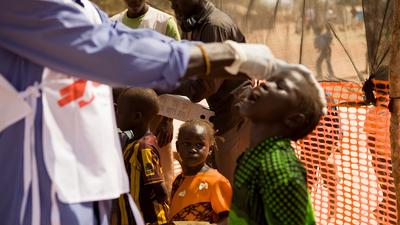Vaccines are among our most important medical tools for protecting the health of children. And yet, vaccines are also extremely challenging to use in developing countries.
Most vaccines must be kept at 2-8°C (35-46°F), or they will spoil. Storing, transporting and administering them in conditions where Médecins Sans Frontières/Doctors Without Borders (MSF) works are some of our biggest logistical challenges.
The problem of electricity
In wealthy countries, where reliable electricity for refrigeration is readily available, it’s easy to ship and store vaccines within this strict temperature range. But in the developing world, particularly in hot countries like those in sub-Saharan Africa, it’s often difficult or impossible. Electricity may be unstable, and temperatures in a country like Chad can rise to 45°C (113°F), far beyond the safe range.
To keep vaccines at the right temperature, we maintain a ‘cold chain’ of refrigeration through every step of their trip from the factory to the children who need them.
A Delicate Balance
It starts at a warehouse, like the one MSF operates in Brussels. We load shipments to the field onto trucks with ice-lined fridges for extra protection against power failures. They’re transferred to airplanes - not cargo ships. Air travel is faster than delivery by sea, reducing the risk of a break in the cold chain.
When the vaccines reach their destination country, we move them to fridges in an MSF storage facility.
There, logisticians assemble orders bound for vaccination sites. They pack the shipments in coolers lined with ice packs and equipped with special temperature monitors. On arrival, those monitors tell us whether the vaccines got too hot or cold along the way.
We usually bring vaccines to the countryside in four-wheel drive cars. Where roads are impassable or dwindle down to trails, we may transfer the shipment to motorcycles to reach the vaccination site - or haul it in by hand.
Transportation is critical
“The closer to the patient, the more critical transport can become,” says MSF Cold Chain Logistician Malcolm Townsend. “For example, large cold boxes are hand-carried over rough paths, which sometimes need to be cleared of vegetation - or include river crossings - in order to reach the vaccination sites.”
If we succeed in maintaining the right temperature, the vaccines arrive intact. We’ll use them to immunize hundreds of children over several days in what’s known as a vaccination campaign.
Vaccination campaigns are commonly organized against diseases like measles, yellow fever, or meningitis, but there are other diseases that are increasingly addressed with large-scale campaigns.
The cold chain is expensive to manage and the outcome is hard to control. If the system fails, vaccines will spoil due to overheating or freezing. And for clinics in developing countries, which must store vaccines for weeks or months until they’re used, the passive cold chain – ice-lined boxes, in other words – can’t make up for a lack of refrigeration.
What’s needed is a solution that takes the fridge out of the equation.
A Better Way
While working to strengthen the cold chain is important, MSF is also advocating for another alternative, centering on the vaccines themselves.
We’re asking pharmaceutical companies to develop vaccines that are easier to use, with greater tolerance for heat so that they can be kept outside of refrigeration.
We also want manufacturers to collect data showing how well their vaccines perform outside the cold chain, then use that information to make the storage recommendations as flexible as possible. Some vaccines are known to be less sensitive than others and can potentially stay unrefrigerated for certain periods of time.
Outside the cold chain
Only one vaccine has so far been approved for use outside the cold chain. The meningitis A vaccine called MenAfriVac was developed specially for Africa’s ‘meningitis belt,’ where the disease is common and where temperatures are high.
By conducting studies on the vaccine in its real-world environment, it was found that MenAfriVac remained just as effective in a flexible cold chain – that is, left unrefrigerated for short periods of time. By eliminating the expensive cost chain, the cost to vaccinate a person was cut in half.
Best of all, the flexible cold chain allows us to reach more children.
MSF has also started to gather our own data. Epicentre, MSF’s research arm, conducted a study in Chad on a tetanus toxoid vaccine to see how effective it is when unrefrigerated. The vaccine was left out of the cold chain for 30 days at up to 40°C. Results showed that study participants who received this vaccine reached adequate levels of protection against tetanus.
Today, one in five children around the world goes unvaccinated every year – more than 22 million in all.
With temperature-tolerant vaccines, health ministries and humanitarian groups like MSF can deliver vital protection to greater numbers of children, especially those hardest to reach.




